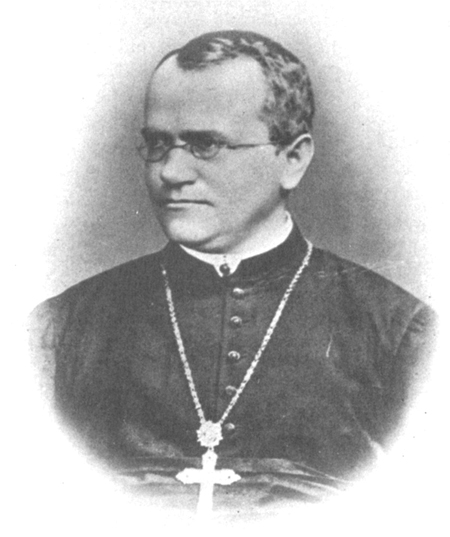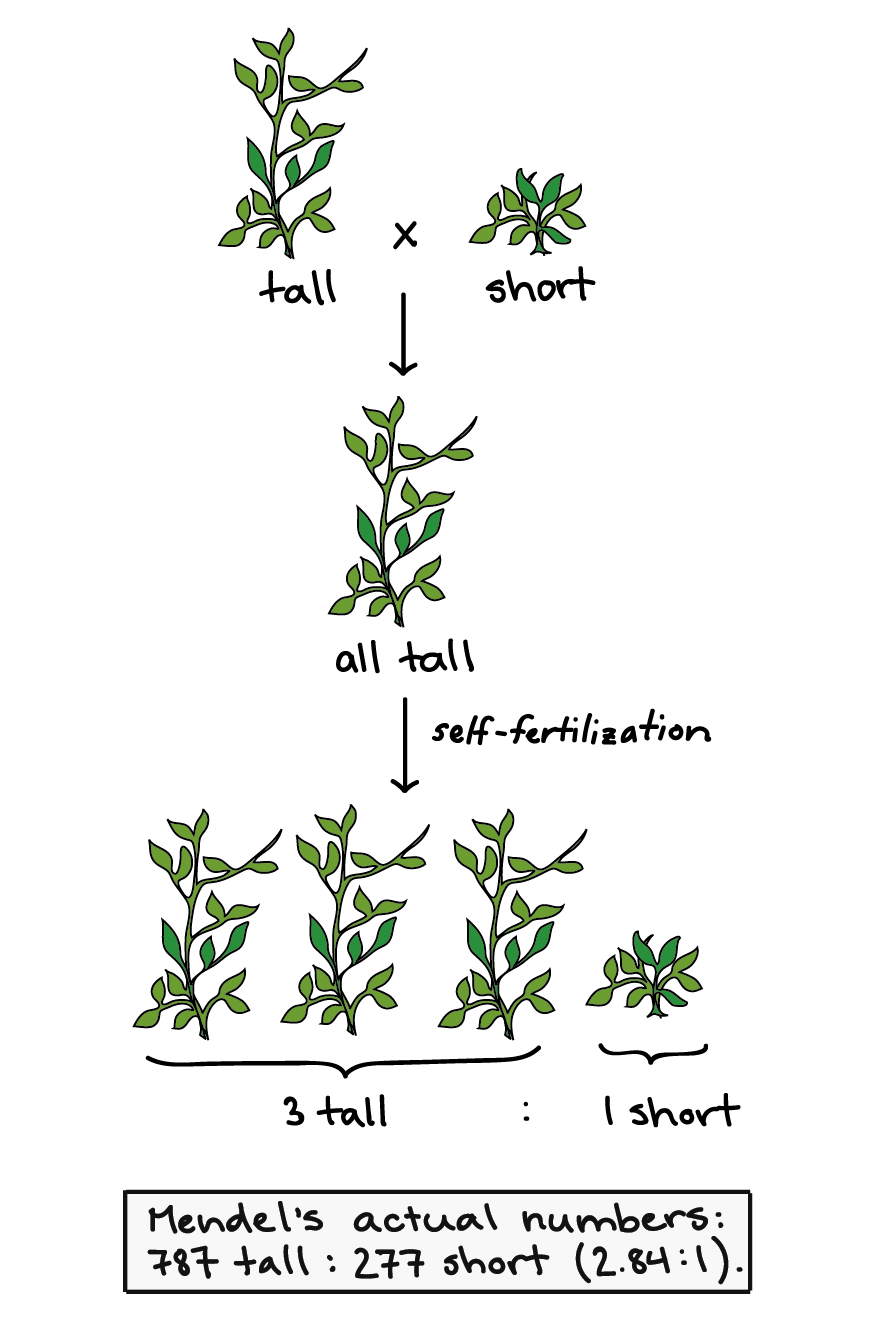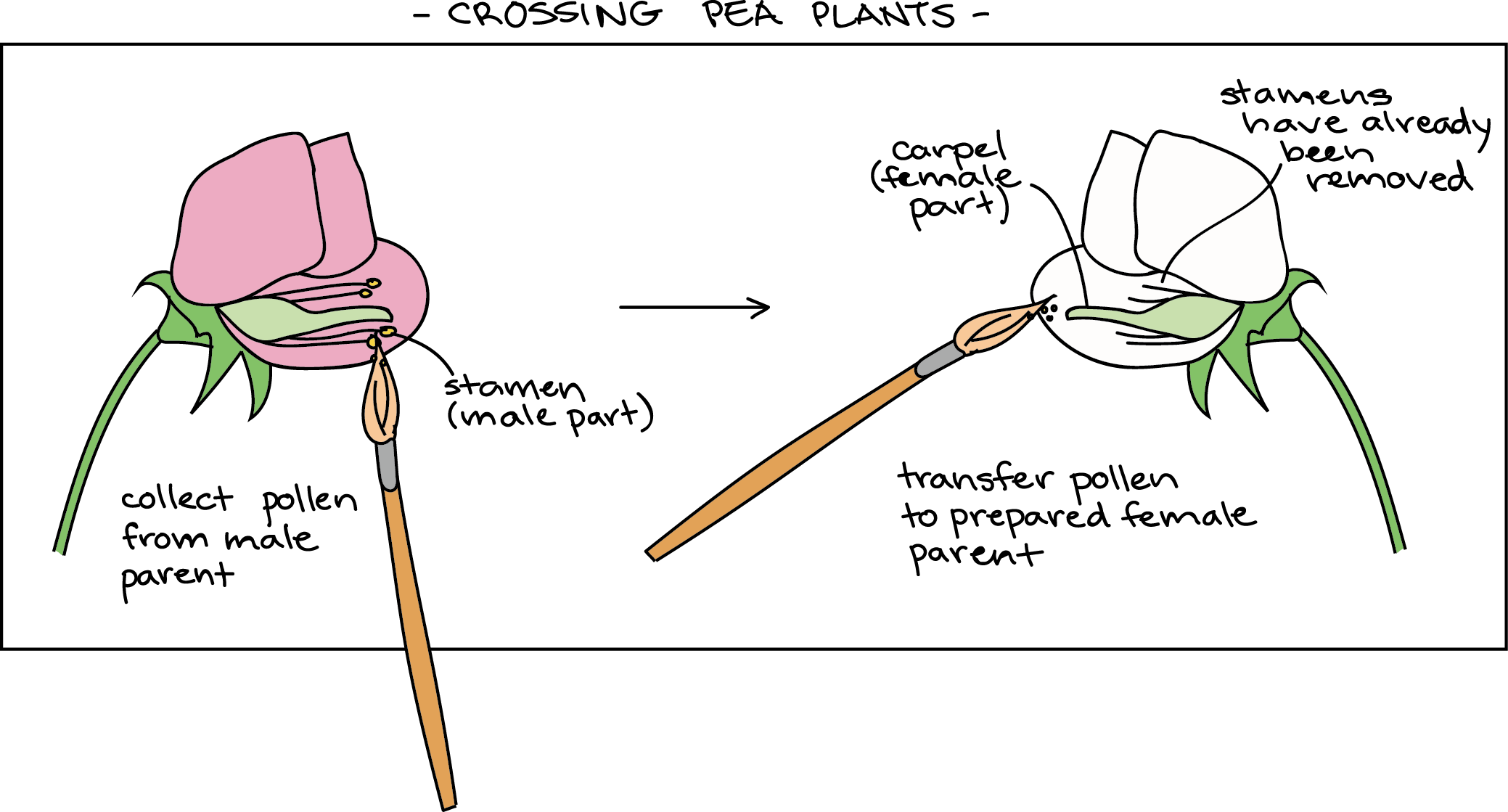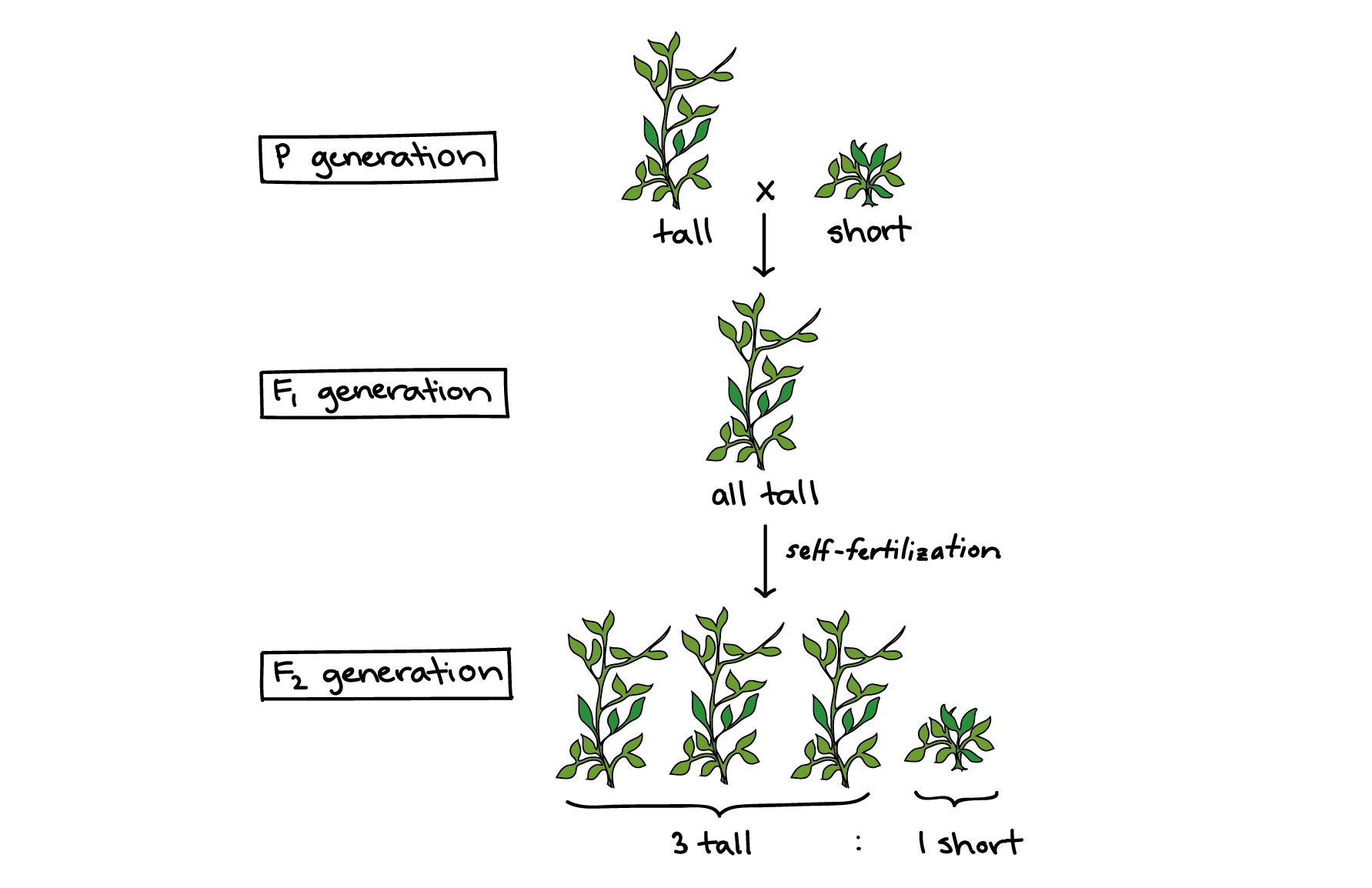1.4: Mendel and his peas
- Page ID
- 73821
How can we study inheritance?
When spending time with your own family, friends, and neighbors, you may have noticed that many traits run in families. For instance, members of a family may share similar facial features, hair color (like the brother and sister below), or a predisposition to health problems such as diabetes. Characteristics that run in families often have a genetic basis, meaning that they depend on genetic information a person inherits from his or her parents.

What if you wanted to figure out how genetic information is transmitted between generations? For instance, you might be curious how traits can "skip" a generation, or why one child in a family may suffer from a genetic disease while another does not. How could you go about asking these kinds of questions scientifically?
An obvious first idea would be to study human inheritance patterns directly, but that turns out to be a tricky proposition (see the pop-up below for details). In this article, we'll see how a nineteenth-century monk named Gregor Mendel instead uncovered the key principles of inheritance using a simple, familiar system: the pea plant.
- [Why didn't Mendel study humans?]
-
Many of us are curious about genetics because we want to understand human inheritance. If the burning questions of genetics are about humans, why would anyone study inheritance in something like the pea plant?
When it comes to basic principles of inheritance, humans may be the organisms we most want to learn about, but they aren't always the best organisms to study experimentally. For instance, it takes many years for a human being to grow, mature, and have children, making data collection slow. Also, when humans have children, they often have one or two (rather than, say, several thousand), making it harder to see mathematical patterns in the data. Finally, and perhaps most critically, it wouldn’t be possible (or ethical) to set up controlled experiments in human genetics – that is, you couldn’t ask a pair of people to have children just because you were curious what those children would look like.
Peas, on the other hand, grow quickly, make many seeds, and can be bred to one another in a simple, controlled way. In other words, they’re good organisms to study in many ways that humans aren’t. Using pea plants, Mendel was able to uncover fundamental principles of inheritance that apply to many different kinds of organisms. Although these principles would have been nearly impossible to deduce from human family trees alone, they form the core of the modern field of human genetics. Mendel’s laws, and later findings building on those laws, allow us to understand and predict the inheritance of many human traits, including genetic disorders.
The monk in the garden: Gregor Mendel
Johann Gregor Mendel (1822–1884), often called the “father of genetics,” was a teacher, lifelong learner, scientist, and man of faith. It would be fair to say that Mendel had a lot of grit: he persevered through difficult circumstances to make some of the most important discoveries in biology.

As a young man, Mendel had difficulty paying for his education due to his family's limited means, and he also suffered bouts of physical illness and depression; still, he persevered to graduate from high school and, later, university1. After finishing university, he joined the Augustinian Abbey of St. Thomas in Brno, in what is now the Czech Republic. At the time, the monastery was the cultural and intellectual hub of the region, and Mendel was immediately exposed to new teachings and ideas1.
His decision to join the order (against the wishes of his father, who expected him to carry on the family farm) appears to have been motivated in part by a desire to continue his education and pursue his scientific interests2. Supported by the monastery, he taught physics, botany, and natural science courses at the secondary and university levels.
Research on heredity
In 1856, Mendel began a decade-long research project to investigate patterns of inheritance. Although he began his research using mice, he later switched to honeybees and plants, ultimately settling on garden peas as his primary model system2. A model system is an organism that makes it easy for a researcher to investigate a particular scientific question, such as how traits are inherited. By studying a model system, researchers can learn general principles that apply to other, harder-to-study organisms or biological systems, such as humans.
Mendel studied the inheritance of seven different features in peas, including height, flower color, seed color, and seed shape. To do so, he first established pea lines with two different forms of a feature, such as tall vs. short height. He grew these lines for generations until they were pure-breeding (always produced offspring identical to the parent), then bred them to each other and observed how the traits were inherited.
In addition to recording how the plants in each generation looked, Mendel counted the exact number of plants that showed each trait. Strikingly, he found very similar patterns of inheritance for all seven features he studied:
- One form of a feature, such as tall, always concealed the other form, such as short, in the first generation after the cross. Mendel called the visible form the dominant trait and the hidden form the recessive trait.
- In the second generation, after plants were allowed to self-fertilize (pollinate themselves), the hidden form of the trait reappeared in a minority of the plants. Specifically, there were always about 3 plants that showed the dominant trait (e.g., tall) for every 1 plant that showed the recessive trait (e.g., short), making a 3:1 ratio.
- Mendel also found that the features were inherited independently: one feature, such as plant height, did not influence inheritance of other features, such as flower color or seed shape.

In 1865, Mendel presented the results of his experiments with nearly 30,000 pea plants to the local Natural History Society. Based on the patterns he observed, the counting data he collected, and a mathematical analysis of his results, Mendel proposed a model of inheritance in which:
- Characteristics such as flower color, plant height, and seed shape were controlled by pairs of heritable factors that came in different versions.
- One version of a factor (the dominant form) could mask the presence of another version (the recessive form).
- The two paired factors separated during gamete production, such that each gamete (sperm or egg) randomly received just one factor.
- The factors controlling different characteristics were inherited independently of one another.
We'll take a closer look at how Mendel reached these conclusions in the articles on the law of segregation and the law of independent assortment. In 1866, Mendel published his observations and his model of inheritance, under the title Experiments in Plant Hybridization3,4, in the Proceedings of the Natural History Society of Brünn.
Scientific legacy
Mendel's work went largely unnoticed by the scientific community during his lifetime. How could this have been the case?
In part, Mendel's contemporaries failed to recognize the importance of his work because his findings went against prevailing (popular) ideas about inheritance. In addition, although we now see Mendel's mathematical approach to biology as innovative and pioneering, it was new, unfamiliar, and perhaps confusing or unintuitive to other biologists of the time5.
In the mid-1800s, when Mendel was doing his experiments, most biologists subscribed to the idea of blending inheritance. Blending inheritance wasn't a formal, scientific hypothesis, but rather, a general model in which inheritance involved the permanent blending of parents' characteristics in their offspring (producing offspring with an intermediate form of a characteristic)6. The blending model fit well with some observations of human inheritance: for instance, children often look a bit like both of their parents.
But the blending model could not explain why Mendel crossed a tall and a short pea plant and got only tall plants, or why self-fertilization of one of those tall plants would produce a 3:1 ratio of tall to short plants in the next generation. Instead, if the blending model were correct, a tall plant crossed with a short plant should produce a medium plant, which would go on to produce more medium plants (see below).

As it turns out, both pea plant height and human height (along with many other characteristics in a wide range of organisms) are controlled by pairs of heritable factors that come in distinctive versions, just as Mendel proposed. In humans, however, there are many different factors (genes) that contribute fractionally to height and vary among individuals. This makes it difficult to see the contribution of any one factor and produces inheritance patterns that can resemble blending. In Mendel's experiments, in contrast, there was just one factor that differed between the tall and short pea plants, allowing Mendel to clearly see the underlying pattern of inheritance.
In 1868, Mendel became abbot of his monastery and largely set aside his scientific pursuits in favor of his pastoral duties. He was not recognized for his extraordinary scientific contributions during his lifetime. In fact, it was not until around 1900 that his work was rediscovered, reproduced, and revitalized. Its rediscoverers were biologists on the brink of discovering the chromosomal basis of heredity – that is, about to realize that Mendel's “heritable factors” were carried on chromosomes.
Mendel’s model system: The pea plant
Mendel carried out his key experiments using the garden pea, Pisum sativum, as a model system. Pea plants make a convenient system for studies of inheritance, and they are still studied by some geneticists today.
Useful features of peas include their rapid life cycle and the production of lots and lots of seeds. Pea plants also typically self-fertilize, meaning that the same plant makes both the sperm and the egg that come together in fertilization. Mendel took advantage of this property to produce true-breeding pea lines: he self-fertilized and selected peas for many generations until he got lines that consistently made offspring identical to the parent (e.g., always short).
Pea plants are also easy to cross, or mate in a controlled way. This is done by transferring pollen from the anthers (male parts) of a pea plant of one variety to the carpel (female part) of a mature pea plant of a different variety. To prevent the receiving plant from self-fertilizing, Mendel painstakingly removed all of the immature anthers from the plant’s flowers before the cross.

Because peas were so easy to work with and prolific in seed production, Mendel could perform many crosses and examine many individual plants, making sure that his results were consistent (not just a fluke) and accurate (based on many data points).
Mendel’s experimental setup
Once Mendel had established true-breeding pea lines with different traits for one or more features of interest (such as tall vs. short height), he began to investigate how the traits were inherited by carrying out a series of crosses.
First, he crossed one true-breeding parent to another. The plants used in this initial cross are called the P generation, or parental generation.
Mendel collected the seeds from the P generation cross and grew them up. These offspring were called the F1 generation, short for first filial generation. (Filius means “son” in Latin, so this name is slightly less weird than it seems!)
Once Mendel examined the F1 plants and recorded their traits, he let them self-fertilize naturally, producing lots of seeds. He then collected and grew the seeds from the F1 plants to produce an F2 generation, or second filial generation. Again, he carefully examined the plants and recorded their traits.

Mendel's experiments extended beyond the F2 generation to F3, F4, and later generations, but his model of inheritance was based mostly on the first three generations (P, F1, and F2).
Mendel didn’t just record what his plants looked like in each generation (e.g., tall vs. short). Instead, he counted exactly how many plants with each trait were present. This may sound tedious, but by recording numbers and thinking mathematically, Mendel made discoveries that eluded famous scientists of his time (such as Charles Darwin, who carried out similar experiments but didn’t grasp the significance of his results)5.
You can use the links below to learn more about Mendel's laws of inheritance:
- The law of segregation, describing how individual traits are inherited.
- The law of independent assortment, describing how two or more traits are inherited relative to one another.
Contributors and Attributions
Khan Academy (CC BY-NC-SA 3.0; All Khan Academy content is available for free at www.khanacademy.org)
- [Attribution and references]
-
Attribution:
This article is a modified derivative of “Mendel’s experiments and the laws of probability,” by OpenStax College, Biology (CC BY 3.0). Download the original article for free at http://cnx.org/contents/185cbf87-c72e-48f5-b51e-f14f21b5eabd@9.85.
The modified article is licensed under a CC BY-NC-SA 4.0 license.
Works cited:
-
Biography.com Editors. (2015). Gregor Mendel biography. In The Biography.com website. Retrieved from http://www.biography.com/people/gregor-mendel-39282.
-
Gregor Mendel. (2015, 1 September). Retrieved from Wikipedia on September 9, 2015: https://en.wikipedia.org/wiki/Gregor_Mendel.
-
Mendel, J. G. (1866). Versuche über Pflanzenhybriden. Verhandlungen des naturforschenden Vereines in Brünn, Bd. IV für das Jahr 1865, Abhandlungen, 3–47. English translation retrieved from http://www.esp.org/foundations/genetics/classical/gm-65.pdf.
-
Blumberg, R. B. (1997). Mendel's paper in English. In MendelWeb. Retrieved from http://www.mendelweb.org/Mendel.plain.html.
-
Purves, W. K., Sadava, D. E., Orians, G. H., and Heller, H.C. (2004). Genetics: Mendel and beyond. In Life: The science of biology (7th ed.). Sunderland, MA: Sinauer Associates, 189.
-
Blending inheritance. (2015, April 20). Retrieved November 17, 2015 from Wikipedia: https://en.wikipedia.org/wiki/Blending_inheritance.
-
Reece, J. B., Urry, L. A., Cain, M. L., Wasserman, S. A., Minorsky, P. V., and Jackson, R. B. (2011). Mendel used the scientific approach to identify two laws of inheritance. In Campbell Biology (10th ed.). San Francisco, CA: Pearson, 268.
Additional references:
Blending inheritance. (2015, April 20). Retrieved November 17, 2015 from Wikipedia: https://en.wikipedia.org/wiki/Blending_inheritance.
Blumberg, R. B. (1997). Mendel's paper in English. In MendelWeb. Retrieved from http://www.mendelweb.org/Mendel.plain.html.
Gregor Mendel. (2015, 1 September). Retrieved from Wikipedia on September 9, 2015: https://en.wikipedia.org/wiki/Gregor_Mendel.
Hybrid (biology). (2015, October 29). Retrieved November 16, 2015 from Wikipedia: https://en.wikipedia.org/wiki/Hybrid_%28biology%29.
Mendel, J. G. (1866). Versuche über Pflanzenhybriden. Verhandlungen des naturforschenden Vereines in Brünn, Bd. IV für das Jahr 1865, Abhandlungen, 3–47. English translation retrieved from http://www.esp.org/foundations/genetics/classical/gm-65.pdf.
Nature Education. (2014). Gregor Mendel: A private scientist. In Scitable. Retrieved from http://www.nature.com/scitable/topicpage/gregor-mendel-a-private-scientist-6618227.
Purves, W. K., Sadava, D. E., Orians, G. H., and Heller, H.C. (2004). Genetics: Mendel and beyond. In Life: The science of biology (7th ed., pp. 187-212). Sunderland, MA: Sinauer Associates.
Raven, P. H., Johnson, G. B., Mason, K. A., Losos, J. B., and Singer, S. R. (2014). Patterns of inheritance. In Biology (10th ed., AP ed., pp. 221-238). New York, NY: McGraw-Hill.
Reece, J. B., Urry, L. A., Cain, M. L., Wasserman, S. A., Minorsky, P. V., and Jackson, R. B. (2011). Drawing from the deck of genes. In Campbell Biology (10th ed., pp. 267-268). San Francisco, CA: Pearson.
Reece, J. B., Urry, L. A., Cain, M. L., Wasserman, S. A., Minorsky, P. V., and Jackson, R. B. (2011). Mendel used the scientific approach to identify two laws of inheritance. In Campbell Biology (10th ed., pp. 268-269). San Francisco, CA: Pearson.
The origins of genetics. (n.d.). Retrieved from http://images.pcmac.org/SiSFiles/Schools/AL/JacksonCounty/NorthJacksonHigh/Uploads/Presentations/The%20Origins%20of%20Genetics%208-1.ppt.
-

